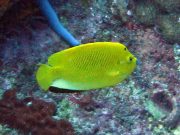Dykning med Ängelfiskar
Lanta Marina Liv | Pomacanthidae
De 96 arterna av kejsarfiskar är några av de mest färgglada och iögonfallande fiskarna som finns i korallreven, och flera arter ses regelbundet på dykturerna i Koh Lanta.
Denna familj har avlånga eller ovala, djupa och kraftigt sammantryckta kroppar, korta nosar, små munnar och borstliknande tänder.
Denna familj har rundade stjärtar och en sammanhängande ryggfena, med grova fjäll som täcker huvudet och kroppen.
Ängelfiskar liknar fjärilsfiskar och nästan alla arter har mycket starka färger med komplexa och varierande färgmönster. En mycket tydlig skillnad mellan fjärilsfiskar och ängelfiskar är att alla arter av ängelfiskar har en framträdande och stark ryggrad längst ner på gälkåpan.
De flesta arter livnär sig på svampdjur och andra marina ryggradslösa djur, vissa livnär sig på plankton.
5 arter finns på denna sida:
Blue Ring Angelfish
(Pomacanthus annularis)
The Blue Ring Angelfish is one of the larger angelfishes, reaching up to 45 cm in length. This species has a golden brown to orangish body with many upward curving blue bands. The tail is white, with a yellow margin and there is a blue ring above the pectoral fin. There are numerous blue markings on the head.

Pomacanthus annularis @ Koh Phi Phi
The Blue Ring Angelfish is sometimes seen alone, but often in pairs. The diet of this species includes sponges, sea squirts and zooplankton.
Juvenile Blue Ring Angelfish have a bluish to black under colour, with narrow, closely spaced pale blue and white bars which are slightly arched, or bowed toward the head. Two or three of these bars are usually wider and more intensely coloured than the rest. The tail fin is white or translucent.
Emperor Angelfish
(Pomacanthus imperator)

Pomacanthus imperator @ Koh Bida
The emperor angelfish is very easy to identify from its bright blue and yellow stripes and yellow tail. This species has a black mask with blue margin across the eyes, and a broad black bar behind the head, again with a blue margin.
The emperor angelfish grows to 38 cm and can be solitary, but often seen in pairs along reef edges. Their diet includes sponges, tunicates (e.g. sea-squirts and other invertebrate filter feeders), and other encrusting organisms.
Juvenile emperor angelfish are dark blue with electric blue and white rings, and a white margin on the dorsal fin.
Blacktail Angelfish
(Centropyge eibli)

Centropyge eibli @ Koh Haa
The blacktail angelfish is one of the larger of the dwarf angelfishes, reaching up to 15 cm in length.
This fish is pale grey with thin brownish / reddish / orange stripes, a black tail and tail base. Both the rear end of the dorsal fin and the tail fin have a sapphire-blue margin.
This species is usually solitary, but may occasionally be seen in pairs. The diet includes soft corals and algae.
Indian Yellowtail Angelfish
(Apolemichthys xanthurus)

Apolemichthys xanthurus @ Koh Haa
The Indian Yellowtail Angelfish has a whitish to cream body colour and a dark margin around the entire body. The face is dark and the body scales have dark tips which gives a spotted effect.
The rear dorsal and anal fins are black with a white margin and the tail fin is yellow.
This species can occasionally be found with the Indian Vagabond Butterflyfish which has a similar appearance.
The Indian Yellowtail Angelfish is a medium sized angelfish, growing to around 15 cm, but more often observed around 10 cm - 12 cm.
This is a shy species, found in pairs and rarely seen at the dive sites around Koh Lanta.
Three-Spot Angelfish
(Apolemichthys trimaculatus)

Apolemichthys trimaculatus @ Hin Muang
The Three-Spot Angelfish has a bright yellow body with a dark spot on the forehead and one each side close to the the gills, at eye-level. The mouth and lips are a vivid blue colour.
There is a grey patch between the eyes and the preopercle spine (spine jutting out below the gills) is light bluish grey.
All the fins are yellow, except for the anal fin which is white with a large black margin.
The Three-Spot Angelfish grows to 26 cm, but more likely observed around 10 cm - 15 cm. The diet includes sponges and tunicates such as sea squirts. Rarely seen at the dive sites around Koh Lanta.
Dykning med Ängelfiskar runt Koh Lanta
Dykning och Snorkelutflykter
Om du vill ha en chans att se Ängelfiskar på en av våra dagliga högsäsongs dykresor från Koh Lanta, skicka oss ett e-postmeddelande till info@diveandrelax.com.
Följ med på våra dykresor med speedboat under högsäsong till några av Thailands bästa dykplatser och njut av små grupper, korta restider och fokus på personlig service, säkerhet och nöje.
Är du ännu inte certifierad dykare? Lär dig att dyka på Koh Lanta med den 3-dagars SSI Open Water Diver-kursen.
Boka online och spara 10 % på dykresor och dykkurser på Koh Lanta.
Ta Reda på Mer
Guider för Marina Djur och Växter i Indo-Stilla Havet
- Allen, G., Steene, R., Humann, P., DeLoach, N. (2003) Reef Fish Identification, Tropical Pacific. Jacksonville, FL., USA: New World Publications, Inc., ISBN 1-878348-36-1.
- Humann, P., DeLoach, N., (2010) Reef Creature Identification, Tropical Pacific. Jacksonville, FL., USA: New World Publications Inc., ISBN 978-1-878348-44-9
- Debelius, H. (2013) Indian Ocean Reef Guide. Frankfurt, Germany: IKAN - Unterwasserarchiv, ISBN 978-3-939767-52-7.
- Debelius, H. (2004) Nudibranchs and Sea Snails, Indo-Pacific Field Guide. Frankfurt, Germany: IKAN - Unterwasserarchiv, ISBN 3-925919-51-1
- Erhardt, H., Knop, D. (2015) Corals Indo-Pacific Field Guide. Frankfurt, Germany: IKAN - Unterwasserarchiv, ISBN 3-925919-69-4.
- Veron J.E.N., Stafford-Smith M.G., Turak E. and DeVantier L.M. (2016). Corals of the World


